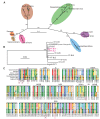Phylogenomic analysis unravels evolution of yellow fever virus within hosts
- PMID: 30188905
- PMCID: PMC6143276
- DOI: 10.1371/journal.pntd.0006738
Phylogenomic analysis unravels evolution of yellow fever virus within hosts
Abstract
The yellow fever virus (YFV) recently reemerged in the large outbreaks in Africa and Brazil, and the first imported patients into Asia have recalled the concerns of YFV evolution. Here we show phylogenomics of YFV with serial clinical samples of the 2016 YFV infections. Phylogenetics exhibited that the 2016 strains were close to Angola 1971 strains and only three amino acid changes presented new to other lineages. Deep sequencing of viral genomes discovered 101 intrahost single nucleotide variations (iSNVs) and 234 single nucleotide polymorphisms (SNPs). Analysis of iSNV distribution and mutated allele frequency revealed that the coding regions were under purifying selection. Comparison of the evolutionary rates estimated by iSNV and SNP showed that the intrahost rate was ~2.25 times higher than the epidemic rate, and both rates were higher than the long-term YFV substitution rate, as expected. In addition, the result also hinted that short viremia duration of YFV might further hinder the evolution of YFV.
Conflict of interest statement
The authors have declared that no competing interests exist.
Figures




Similar articles
-
Yellow Fever Virus Reemergence and Spread in Southeast Brazil, 2016-2019.J Virol. 2019 Dec 12;94(1):e01623-19. doi: 10.1128/JVI.01623-19. Print 2019 Dec 12. J Virol. 2019. PMID: 31597773 Free PMC article.
-
Comparative phylogenies of yellow fever isolates from Peru and Brazil.FEMS Immunol Med Microbiol. 2003 Nov 28;39(2):103-18. doi: 10.1016/S0928-8244(03)00238-4. FEMS Immunol Med Microbiol. 2003. PMID: 14625093
-
Genome analysis and phylogenetic relationships between east, central and west African isolates of Yellow fever virus.J Gen Virol. 2006 Apr;87(Pt 4):895-907. doi: 10.1099/vir.0.81236-0. J Gen Virol. 2006. PMID: 16528039
-
Phylogeographic reconstruction of African yellow fever virus isolates indicates recent simultaneous dispersal into east and west Africa.PLoS Negl Trop Dis. 2013;7(3):e1910. doi: 10.1371/journal.pntd.0001910. Epub 2013 Mar 14. PLoS Negl Trop Dis. 2013. PMID: 23516640 Free PMC article. Review.
-
Evolutionary and ecological factors underlying the tempo and distribution of yellow fever virus activity.Infect Genet Evol. 2013 Jan;13:198-210. doi: 10.1016/j.meegid.2012.08.015. Epub 2012 Sep 3. Infect Genet Evol. 2013. PMID: 22981999 Review.
Cited by
-
Vaccination and Therapeutics: Responding to the Changing Epidemiology of Yellow Fever.Curr Treat Options Infect Dis. 2020;12(4):398-409. doi: 10.1007/s40506-020-00237-2. Epub 2020 Nov 6. Curr Treat Options Infect Dis. 2020. PMID: 33173445 Free PMC article. Review.
-
Yellow fever transmission in non-human primates, Bahia, Northeastern Brazil.PLoS Negl Trop Dis. 2020 Aug 11;14(8):e0008405. doi: 10.1371/journal.pntd.0008405. eCollection 2020 Aug. PLoS Negl Trop Dis. 2020. PMID: 32780745 Free PMC article.
-
Difference of Intrahost Dynamics of the Second Human Pegivirus and Hepatitis C Virus in HPgV-2/HCV-Coinfected Patients.Front Cell Infect Microbiol. 2021 Aug 12;11:728415. doi: 10.3389/fcimb.2021.728415. eCollection 2021. Front Cell Infect Microbiol. 2021. PMID: 34466405 Free PMC article.
-
Yellow Fever Molecular Diagnosis Using Urine Specimens during Acute and Convalescent Phases of the Disease.J Clin Microbiol. 2022 Aug 17;60(8):e0025422. doi: 10.1128/jcm.00254-22. Epub 2022 Aug 2. J Clin Microbiol. 2022. PMID: 35916519 Free PMC article.
-
Low Pathogenicity H7N3 Avian Influenza Viruses Have Higher Within-Host Genetic Diversity Than a Closely Related High Pathogenicity H7N3 Virus in Infected Turkeys and Chickens.Viruses. 2022 Mar 8;14(3):554. doi: 10.3390/v14030554. Viruses. 2022. PMID: 35336961 Free PMC article.
References
-
- Mutebi J-P, Rijnbrand RC, Wang H, et al. Genetic relationships and evolution of genotypes of yellow fever virus and other members of the yellow fever virus group within the Flavivirus genus based on the 3′ noncoding region. Journal of virology 2004; 78:9652–65. 10.1128/JVI.78.18.9652-9665.2004 - DOI - PMC - PubMed
Publication types
MeSH terms
LinkOut - more resources
Full Text Sources
Other Literature Sources

